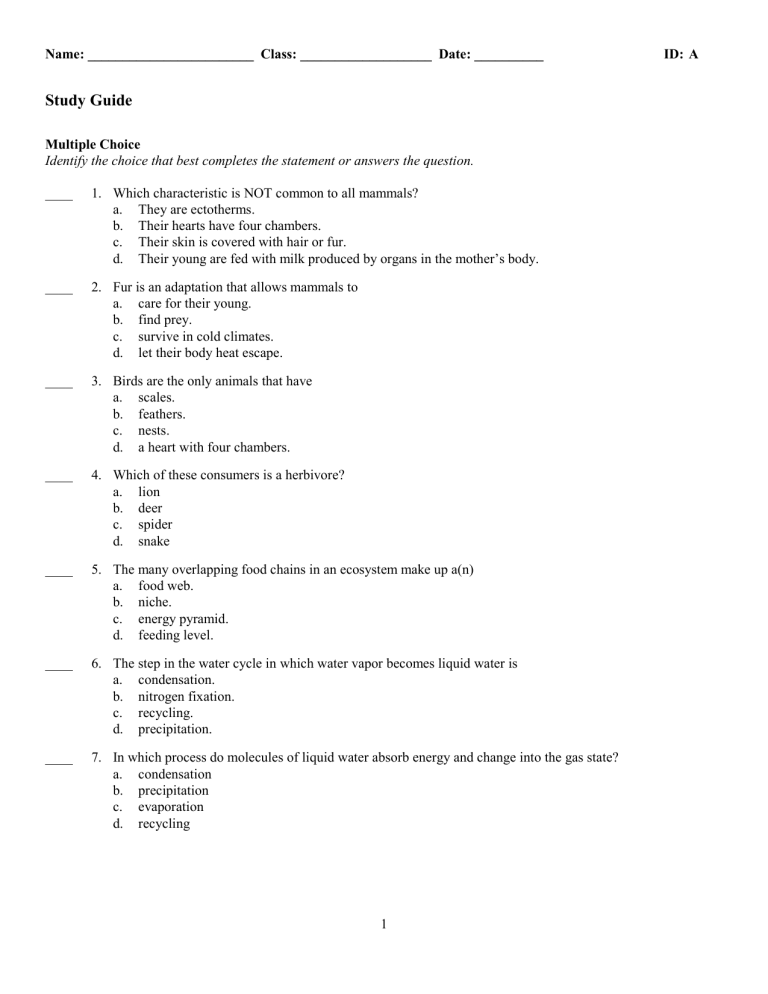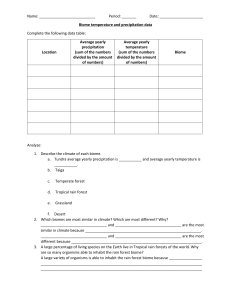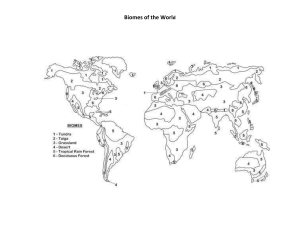
Name: ________________________ Class: ___________________ Date: __________ Study Guide Multiple Choice Identify the choice that best completes the statement or answers the question. ____ 1. Which characteristic is NOT common to all mammals? a. They are ectotherms. b. Their hearts have four chambers. c. Their skin is covered with hair or fur. d. Their young are fed with milk produced by organs in the mother’s body. ____ 2. Fur is an adaptation that allows mammals to a. care for their young. b. find prey. c. survive in cold climates. d. let their body heat escape. ____ 3. Birds are the only animals that have a. scales. b. feathers. c. nests. d. a heart with four chambers. ____ 4. Which of these consumers is a herbivore? a. lion b. deer c. spider d. snake ____ 5. The many overlapping food chains in an ecosystem make up a(n) a. food web. b. niche. c. energy pyramid. d. feeding level. ____ 6. The step in the water cycle in which water vapor becomes liquid water is a. condensation. b. nitrogen fixation. c. recycling. d. precipitation. ____ 7. In which process do molecules of liquid water absorb energy and change into the gas state? a. condensation b. precipitation c. evaporation d. recycling 1 ID: A Name: ________________________ ID: A ____ 8. In which process do producers use carbon from carbon dioxide to produce other carbon-containing molecules? a. the nitrogen cycle b. photosynthesis c. precipitation d. the water cycle ____ 9. A group of land ecosystems with similar climates and organisms is called a(n) a. energy pyramid. b. climate. c. biome. d. food web. ____ 10. Which biome is extremely cold and dry? a. desert b. tundra c. grassland d. mountains ____ 11. Ponds and rivers are two types of a. marine ecosystems. b. rain forest biomes. c. freshwater ecosystems. d. estuary ecosystems. ____ 12. An organism that can make its own food is called a a. consumer. b. decomposer. c. producer. d. scavenger. ____ 13. Which biome receives less than 25 centimeters of rain per year? a. desert b. grassland c. temperate rain forest d. tropical rain forest ____ 14. Which ecosystem is found where the fresh water of a river meets the salt water of the ocean? a. estuary b. neritic zone c. surface zone d. rocky intertidal zone ____ 15. What do producers release as a result of photosynthesis? a. hydrogen b. nitrogen c. oxygen d. carbon dioxide 2 Name: ________________________ ID: A ____ 16. A large variety of plants grows in tropical rain forest because a. many insects live there. b. the forest floor is very dark. c. it has very good soil. d. it is warm, humid, and rainy. ____ 17. Fishes take in oxygen through their a. fins. b. gills. c. scales. d. vertebrae. ____ 18. When the temperature of the environment changes, the body temperature of a reptile a. changes. b. stays the same. c. always increases. d. always decreases. ____ 19. Which of the following is true of all mollusks? a. They have shells. b. They have soft bodies. c. They have segments. d. They have a closed circulatory system. ____ 20. An arthropod’s tough outer covering is called a. an endoskeleton. b. an exoskeleton. c. armor. d. a mantle. ____ 21. Which of the following is a characteristic of insects? a. one pair of antennae b. four legs c. three pairs of wings d. two body sections ____ 22. Which of these is NOT an arthropod? a. centipede b. grasshopper c. snail d. lobster ____ 23. All plants are a. eukaryotes. b. unicellular. c. heterotrophs. d. prokaryotes. 3 Name: ________________________ ID: A ____ 24. Vascular plants differ from nonvascular plants in a. how they make food. b. where they obtain materials. c. how they transport materials. d. how they reproduce. ____ 25. What parts of a fern grow underground? a. roots and fronds b. roots and stems c. stems and leaves d. stems and fronds ____ 26. You would expect to find spores a. on leaf cuticles. b. on moss rhizoids. c. in a new gametophyte. d. on the underside of fern fronds. ____ 27. The reproductive structures of most gymnosperms are called a. pollen. b. ovules. c. cones. d. sperm cells. ____ 28. All angiosperms a. produce cones. b. produce fruits. c. are seedless. d. are tropical. ____ 29. What is a characteristic of a monocot? a. branching veins in its leaves b. flowers with four or five petals c. two cotyledons in each seed d. scattered bundles of vascular tissue in its stem ____ 30. Gases pass in and out of a leaf through the a. phloem. b. xylem. c. cuticle. d. stomata. 4



